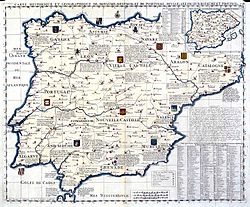Battle of the Vega of Granada
| Disaster of the Vega de Granada | |||||||
|---|---|---|---|---|---|---|---|
| Part of the Spanish Reconquista | |||||||
 The Nasrid Kingdom of Granada | |||||||
| |||||||
| Belligerents | |||||||
|
|
| ||||||
| Commanders and leaders | |||||||
|
|
| ||||||
| Strength | |||||||
| More than 10,000 | About 5,000 | ||||||
| Casualties and losses | |||||||
| (Unknown) | (Unknown) | ||||||
| History of Spain |
|---|
 |
| Timeline |
The Battle of Sierra Elvira, also called Disaster of the Vega de Granada, was a battle of the Spanish Reconquista fought near the city of Granada in 1319. The battle was fought between the troops of the Kingdom of Granada and those of the Kingdom of Castile. The battle resulted in a catastrophic defeat for Castile.[1]
Historical Context
The nobility of the Kingdom of Castile was quite used to periodical military raids into the Kingdom of Granada in order to collect booty. Notwithstanding temporary agreement and truces with the Nasrid rulers these expeditions were often performed under the leadership of the very same rulers of Castile. They were often true military expeditions with large armies in the thousands of men. In the late 1310s Castile was ruled by King Alfonso XI, a minor, under the joint regency of his grandmother Maria de Molina, of his granduncle infante John and of his uncle infante Peter. Infante Peter had led minor raids in granadine territory in 1316 and 1317 [2] and an agreement had been reached with the nobility of Castile in the Cortes held at Medina del Campo in 1318 for a new expedition to be done in late spring 1319. This expedition was to be a large one, blessed even by Pope John XXII who authorized to qualify it as a crusade and conceded the rebate to the crown of some of the Church tithes in order to finance it.[3] The troops met in Cordoba in the month of June 1319 and crossed the border under the leadership of infante Peter. With him were the Grand Masters of the Orders of Santiago, Calatrava and Alcántara and the Archbishops of Toledo and Seville. Infante John followed with his own troops. The two infantes resolved to march deep into the granadine kingdom and to reach the Vega de Granada, the plain territory immediately close to the town characterized for its fertility and its wealth. During the march the large army sustained various skirmishes with Moorish troops and conquered several places, collecting a substantial booty.
The battle
The large Castilian army encamped in the Vega de Granada [4] and, after probably raiding the immediate vicinities, resolved to return to Castile satisfied with the collected booty. A siege of the town of Granada was deemed impossible at the time. The retreat started on 25 June 1319, under a very intense heat; infante Peter lead the vanguard while infante John marched in the rear of the army. However at this point King Ismail I of Granada decided to strike. A large cavalry force of élite Moorish troops, the "Volunteers of the Faith", led by Uthman ibn Abi al-Ula, exited from Granada and started harassing the retreating Castilians of infante John. These minor attacks turned probably into a general one once the Granadines realized the Castilians did not succeed in defending themselves and had lost cohesion. Infant John called on infante Peter for help but this one, according to chroniclers, was at first dissuaded from his companions and then, when anyhow resolved to lead the vanguard to help his uncle, fell from his horse being trampled dead. At this point the vanguard thought only to flee and to regain the Castilian border, with many men drowning while attempting to cross in full armour the rio Genil. The rear of the army, without help, simply collapsed with the aged infante John falling victim probably of a stroke,[5] leading to a spectacular Moorish victory.[6] The locality where most of the fighting took place was in the present municipality of Pinos Puente and from the fact that both infantes had died there took the name of Cerro de los Infantes.
Aftermath
Numbers are not available for the losses sustained by the Castilians but they had to be quite large. The border for some years after 1319 was undermanned and for this reason the Granadines could raid almost at will the southern Castilian territories. Maria de Molina remained as sole regent and was later joined by her other son infante Philip and by a distant relative, the celebrated Juan Manuel.[7] In 1325 Alfonso XI started to rule alone and soon started his lifelong and in the end victorious struggle with the Nasrid kingdom and its later ally, the Marinids of Fez, which was also intended to avenge the 1319 defeat.
References
External links
- El lado oscuro de la Historia. "EL DESASTRE DE LA VEGA DE GRANADA....Jo".
- Legado Nazari. "La Batalla de Sierra Elvira o "El Desastre de la Vega de Granada"".
- El Legado Andalusí. "Sierra Elvira, escenario de la Granada islámica".
Bibliography
- Bleiberg (editor), German (1979). Diccionario de Historia de España (3 vols.). Alianza Editorial, Madrid.
{{cite book}}:|last=has generic name (help)CS1 maint: location missing publisher (link)
- Ladero Queisada, Miguel Ángel (1989). Granada. Historia de un país islámico. Editorial Gredos, Madrid.
{{cite book}}: CS1 maint: location missing publisher (link)
- Suárez Fernández, Luis (1975). Historia de España Antigua y Media (2 vols.). Ediciones Rialp, Madrid.
{{cite book}}: CS1 maint: location missing publisher (link)
- A rich bibliography is available in the Spanish Wikipedia
